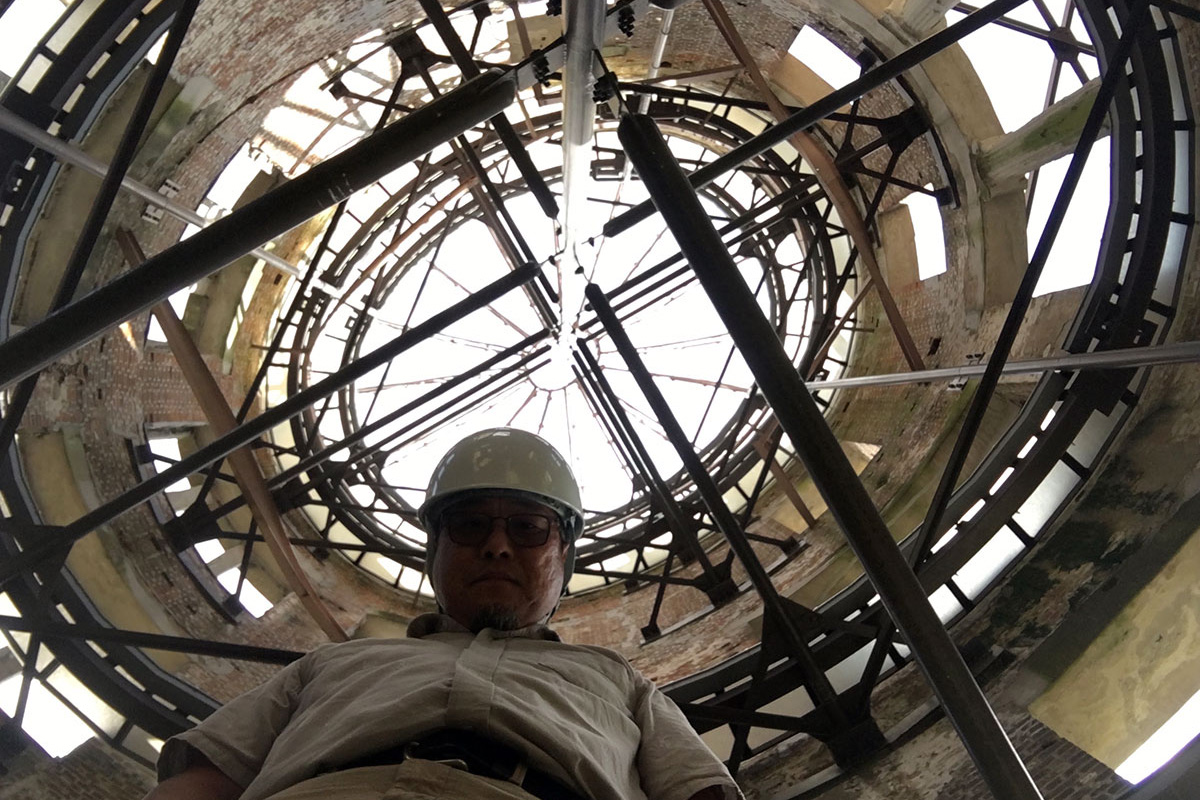When there has been a constant ringing in your ears for your entire life, you learn to appreciate noise. Outside it may be traffic, airplanes, birds, and bugs drowning out the internal buzz. In an office, the drone of air conditioning, fluorescent lights, and a digital projector.
This is the case for audio artist Alan Nakagawa, who recently visited our office at the Center for Folklife and Cultural Heritage. His chronic tinnitus, which he first became aware of at age five, has in part led to a career in recording atmospheric sounds in unlikely locations, developing audio installations in public spaces, and sharing the experience—sometimes joyous, sometimes unpleasant—of noise. His work has sent him around the world, recording in his hometown of Los Angeles, his family’s roots in Hiroshima, and beyond.
“I like noise, but I feel the connotation of noise has overpowered the actual meaning,” Nakagawa told us. “If we were to enjoy or understand noise a little bit better, I think we would be able to hear each other a little bit better.”
It’s true that the word “noise” often carries a negative connotation, even etymologically. It stems from the same Latin root as “nautical” and “nausea”—if you can imagine the sound of someone getting seasick. But Nakagawa sees noise simply as a subjective interpretation of sound, just like music—both experienced according to our emotions and personal aesthetics. By always listening with an open mind, he is intrigued and inspired by the sounds around him.
“Creative listening leads to interpreting, reacting, assessing and contributing to a social dialogue through the muscles of communication and imagination,” he writes.
In one such reinterpretation, Nakagawa connects the architecture and sounds of two iconic structures in Barcelona and Los Angeles. He remembers flipping through an art history book in fourth grade, seeing a photo of Antoni Gaudí’s La Sagrada Família, and thinking that he ripped off Italian American construction worker-turned-artist Simon Rodia, creator of the Watts Towers found-object sculpture. Not realizing Gaudí broke ground nearly forty years earlier than Rodia, he found similarities in the buildings’ otherworldly spires.



For Conical Sound, Nakagawa placed audio recorders at the base of Watts Towers and contact microphones—which pick up audio vibrations in solid objects rather than soundwaves in the air—on the towers themselves. Once manipulated in ProTools, the result is like crashing swells of the ocean or a thunderstorm rolling overhead. Across the world, he was able to record inside Sagrada Família: at ground level, at fifty feet up among the columns, and just below the geometrically angled ceiling. Footsteps, murmurs, and choirs echo strangely in Nakagawa’s soundscape. As a performance piece, he overlays these and other recordings to immerse listeners in the existing locations and to collectively imagine a surreal space somewhere in between.
In a sister project called Peace Resonance, Nakagawa delves into his own cultural heritage by sonically linking landmarks in Hiroshima, Japan, and Wendover, Utah. His family lived in the outskirts of Hiroshima, out of range of the atomic bombing in 1945 but forever affected by the aftermath. His parents met aboard a ship en route to the United States, where Nakagawa was born. In 2016, he made a pilgrimage to Hiroshima to record sounds inside the Atomic Bomb Dome, the only structure left standing near ground zero, now designated as a UNESCO World Heritage Site.
“Nobody gets to go inside the dome!” he remarked, but his artistic vision has consistently granted him unusual access.

In a soundscape form, Nakagawa will present these recordings in a rather ominous location deep in the desert of Utah: the Enola Gay hangar. From there, the B-29 bomber flew nearly 6,000 miles and decimated the Japanese city, killing 80,000 people immediately and up to 80,000 more from fallout in the few months following. The sounds he captured are staticky and unsettling, as distant voices mutate in the imagination to shrieks, the rumble of wind to collapsing buildings.
When Nakagawa began the project, unsure of its final product, he suddenly began getting calls and emails from Hiroshima and Nagasaki bomb survivors who were interested in sharing their stories and learning more. He was invited to a memorial ceremony. A group of survivors—including the youngest on record, from in the womb—even traveled to California to experience an early iteration of Nakagawa’s installation at Cerritos College. Through such an abstract artwork focused on one of the most horrific events in history, he has salvaged creative relationships with individuals and a whole community of survivors.
These and other projects are part of Nakagawa’s push for “creative listening”: more than just listening to respond in conversation, but listening to understand and appreciate noises around us. He gave an example of people who hear foreign languages as noise.
“The moment they hear other languages, they feel threatened,” he said. “Some people actually get angry—like, ‘speak English!’ That’s because of fear, that they see that as noise. But if they saw noise as a different thing, like a good thing, they would listen to other languages as a beautiful thing.”
In our work with the Smithsonian Folklife Festival and Smithsonian Folkways Recordings, we often cite the social power of music to build communities and identity. In the same way, Nakagawa says the social power of noise is promoting receptivity: to our neighbors, strangers, the ringing within us, and the whole world around us.
Elisa Hough is a found-sound collector and the editor at the Center for Folklife and Cultural Heritage.


